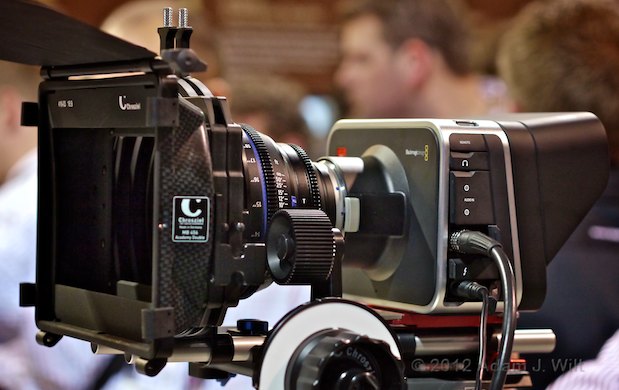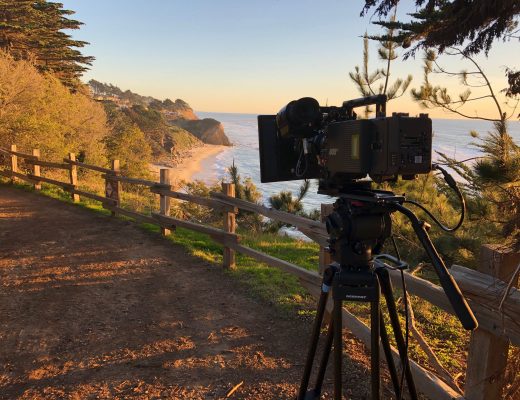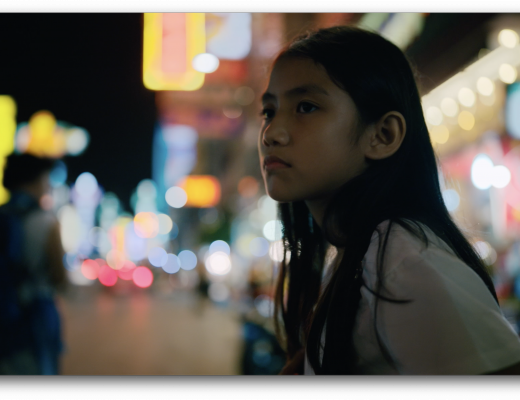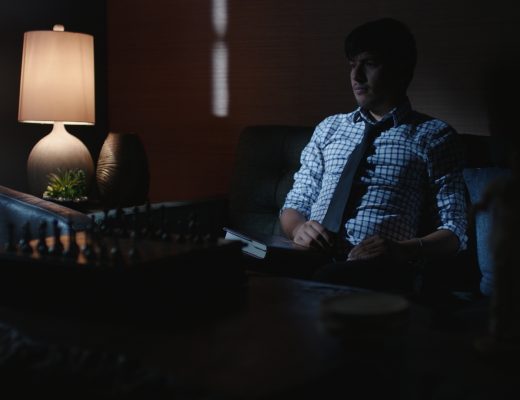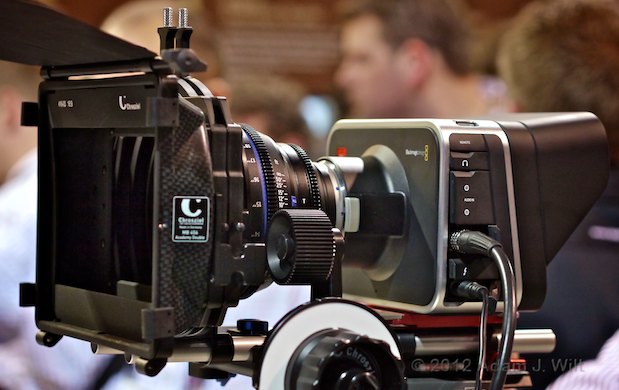
The Blackmagic Design Cinema Camera was the surprise of the show. In this second report on the BMDCC, I gather together facts (such as they are at this early stage of the game), informed commentary, crazed guesswork, and pointers to more info. [updated 2012-04-29: CinemaDNG data rate corrected; 2012-05-07: better video embedding.]
Specifications
First, to avoid all the confusion, here are the actual specs for the camera, at least so far:
http://blackmagic-design.com/products/blackmagiccinemacamera/techspecs/
Notable Items and Additional Info
• The active area is indeed 15.6 x 8.8mm. Compare this to:
– the Panasonic GH2 (18.7 x 10.5mm) and AG-AF100 (17.8 x 10.0mm), both four-thirds cameras;
– the Digital Bolex (12.85 x 9.64mm; 1.33:1 aspect ratio, roughly Super16mm size) and Ikonoskop A-Cam dII (10.6 x 6.0mm, roughly 16mm size), both CinemaDNG raw-recording cameras.
Put another way, the BMDCC sensor’s active area is 83% the width of the GH2’s, 88% of the AF100’s, 121% of the Digital Bolex’s, or 147% of the A-Cam dII’s; it’s halfway between four-thirds and Super16 (nice comparison charts in articles by Reid and Solorio, referenced below), with all the implications that has for depth of field and for noise levels at a given sensitivity.
• While the sensor is indeed a “2.5K sensor” at 2592 x 2192, the active area is 2432 x 1366. This is still enough, given the right deBayering, to yield a theoretical resolution of 1945 x 1093 (80% of the photosite count in either direction), which should yield a clean, sharp 1080p image.
It also means that, should BMD so decide and the hardware allow, the viewfinder could show a “lookaround area” using the rest of the sensor, much as RED and Arri Alexa—and many film cameras with optical finders—do.
• Despite some video statements to the contrary, there is no evidence that AES/EBU digital audio will allowed as an input choice; BMD’s Dan May and two other BMD folks denied it when I asked, and the spec sheet says nothing about it. So why did Dan imply its inclusion in FreshDV’s video? Having done demo-dog duty myself at NCGAs, SIGGRAPHs, IBCs, and NABs over the course of 20 years (!), I can attest to the fatigue and confusion that sometimes besets booth personnel, especially if they’ve come to the show after weeks of frantic preparation and many sleepless nights. Dan may have momentarily confused the BMDCC’s audio flexibility with that of many of BMD’s various Mini Converters, a perfectly natural mistake when surrounded by packs of ravenous journalists.
Or, perhaps, the BMDCC will support AES/EBU audio input. We won’t really know until it ships.
Analog audio input will be line/mic switchable in the release firmware.
• It’s interesting to note that the camera supports four channels of audio. It has those two 1/4″ TRS (balanced) inputs, plus a tiny built-in mike below the sensor bulge. I wonder if all three inputs can be live at the same time; it’d be useful to have the built-in mike audio as a scratch track in case something goes wonky with the 1/4″ feeds.
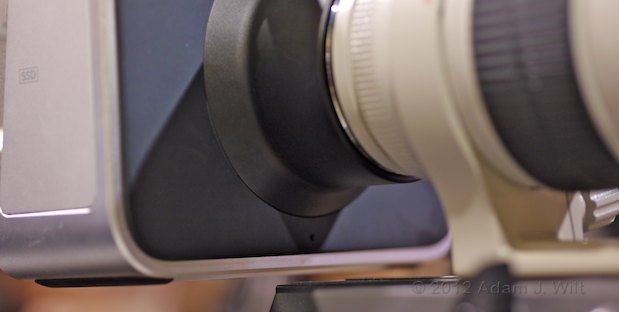
That small hole below the lens mount is where the built-in mike lives.
• The BMD folks agree that some sort of audio level metering in the camera itself is essential. I expect we’ll see it displayed on the touchscreen by the time the camera ships.
• I would add that some sort of exposure indicator—waveform monitor, histogram, and/or RED-style over/under “goal posts”—is equally desirable.
• The camera uses a Canon-compatible EF mount. EOS lens apertures can be adjusted using the FWD/REV transport buttons on the camera’s back panel (at present, though, there’s no iris readout on the camera; that would be another nice thing to see in the release firmware).
It’s a good choice in terms of widespread lens availability, but a bit limiting on the wide end given the comparatively small sensor. A “normal” lens for the BMDCC will be something like a 20mm, so ultrawide EF-mount lenses like the Tokina 11-16mm f/2.8, Canon EF-S 10-22mm, or the Canon EF 14mm f/2.8L are your best wide-angle bets. The widest Zeiss ZE lens, the Distagon 18mm F/3.5, isn’t very wide on a 15.6mm-wide sensor.
On the other hand, telephoto will be easy!
• The two non-raw formats will be DNxHD 220 and ProRes 422 (HQ), both at 1920×1080. These HD formats will be created from the entire 2432 x 1366 raster; they aren’t windowed center-cuts. Thus, if the built-in deBayering is up to snuff, they should be as sharp and detailed as 1080p images created in post from full-raster CinemaDNG recordings.
• CinemaDNG files will probably consume around 8.5 – 10.6 GB/minute, depending on frame rate. The DNxHD and ProRes files will be about 1/5 – 1/6 of that data rate.
• The maximum frame rate of 30fps is said to be limited by the speed of recording CinemaDNG files to SSD. There was no discussion of faster frame rates for lower-data-rate ProRes or DNxHD; it might be the case that 30fps is as fast as the data can be read off the sensor and/or processed for recording.
• The camera consumes about 18 watts of power, including a Peltier-effect cooler on the back of the sensor to regulate its temperature (thus controlling dark-current noise and temperature-dependent shading errors).
• Rolling shutter? Yeah, it’s there. Serious? Not really; I had to try pretty hard to provoke it. It’s probably on the order of the rolling shutter in the RED ONE, a PMW-EX1, or the like; much better than on a Canon DSLR or the GH2.
• Gammas can be set individually (to “Film”/log or “Video”/709) for recording and for display / SDI output.
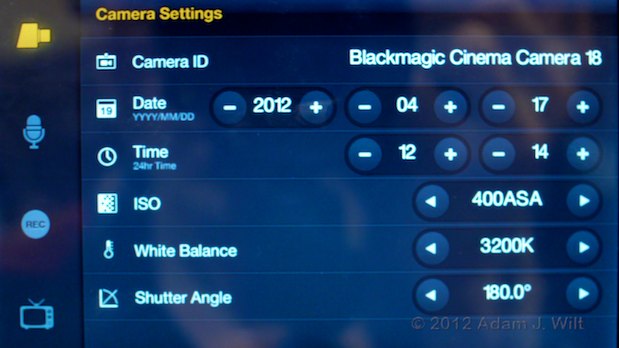
Camera Settings menu as of NAB. ISO selections are 400, 800, or 1600.
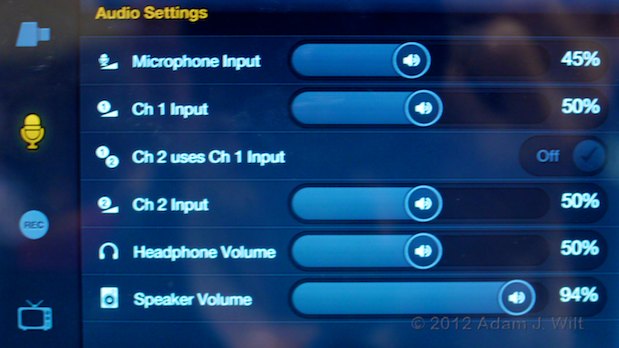
Audio Settings menu as of NAB. Line/Mic selection not yet present.
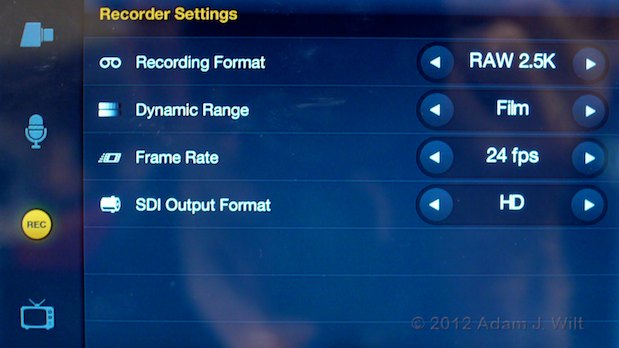
Recorder Settings menu as of NAB. Note the “Dynamic Range” selection.
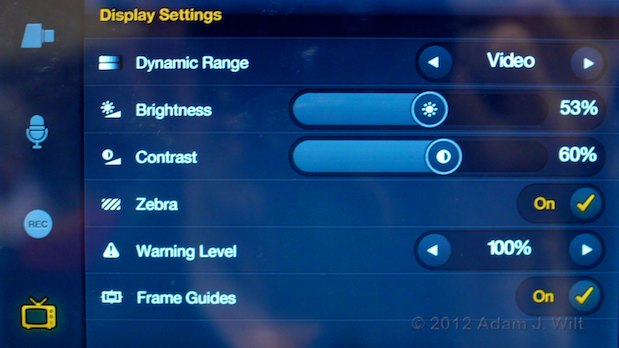
Display Settings menu as of NAB. Note the “Dynamic Range” selection.
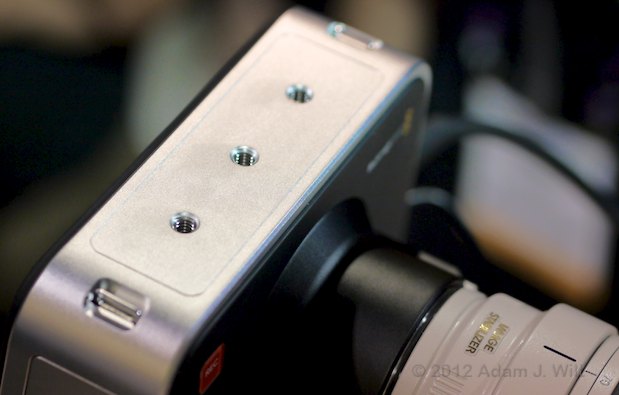
Top of camera: three 1/4″ mounting points.
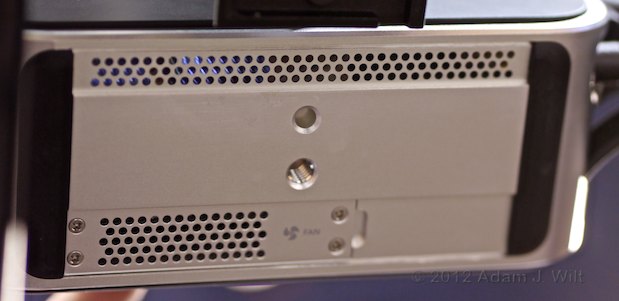
Underside of camera: one 1/4″ socket with anti-rotation hole; ventilation grilles; fan access.
What Blackmagic Design has to Say
I caught up with BMD’s chap in charge of Video Product Sales for the Americas, the ever-affable Dan May, on Wednesday afternoon—after he’d had a chance to get his spiel smooth and polished. He gives us an overview of what the camera is and what it does, and has (I think) an entirely realistic view of where it will fit in the marketplace:
Other Commentary
The two best takes I’ve seen come from a couple of chaps, Andrew Reid at EOSHD.com, and Marco Solorio of OneRiver Media. Both are worth reading.
• Reid says that “the downfall of the big guys just began”.
• Solorio gives a more nuanced view, asking “is this the much anticipated DSLR Killer that many have been waiting for?”
My take on it.
In 1988, Douglas Adams wrote about an I Ching calculator in “The Long Dark Tea-Time of the Soul”, saying,
It had probably been manufactured in whichever of the South-East Asian countries was busy tooling up to do to South Korea what South Korea was busy doing to Japan.
One might similarly ask: is BMD busily doing to RED what RED did to the rest of the industry a few years ago? And, are they also doing it to Canon’s DSLRs, the Nikon D800, the Panasonic GH2, and the Digital Bolex project while they’re at it? Well, yes and no…
There are substantial similarities between the BMDCC and RED’s cameras. Both are raw-recording, interchangeable-lens cine cameras offered at astonishingly low prices (compared to their competition at the time of release), and both are the products of cranky chaps annoyed with the cost of existing tools. Both come with grading tools (REDCINE-X Pro downloadable from RED; DaVinci Resolve supplied with the BMDCC). Yet they aim at different markets and will attract different customers.
RED set out to build a full-function, pro-level, high-res, Super35mm digital cine camera, compatible with PL-mount lenses and all the paraphernalia attendant on cine-style production. REDs are (comparatively speaking) big, heavy, capable cameras; they cost a lot and need a lot of support equipment, but they’re very flexible, highly configurable, and extremely versatile. A basic RED (body, lens mount, power, monitor or EVF) will run you about $15,000 or more.
The BMDCC is a more tightly-focused tool: a raw-capable, reasonably large-sensored cine cam for the lowest possible price. It uses inexpensive EF-mount lenses; it’s “only” 2.4K; it isn’t set up for timecode, genlock, reorientable EVFs, 19mm rods, dovetail plates, matte boxes, and the like… but it does give you (reportedly) 13 stops of dynamic range at slightly better than HD resolution, in raw, ProRes, or DNxHD formats. It’s only $3K.
Thus RED targets high-end filmmaking, spots, and the like. Though its price for the functionality delivered is revolutionary, it’s still not what most folks would call cheap; it’s not a mass-market camera.
The BMDCC is a minimalist camera for a minimalist price: in a way, it’s close to what many people wanted the RED SCARLET to be (“3K for $3K”). In another way, it’s the follow-on to the four-thirds format AG-AF100 that Panasonic didn’t show this year (grin). Raw recording and a large(ish) sensor for $3K? BMD is going to sell a bunch of ’em—as DSLR replacements (for those not using the DSLR’s stills capability), as B-cameras, as pop-it-in-your-bag “sketchbook” cameras, as training cams.
RED may lose a few Scarlet sales to BMD, but I didn’t see anyone at the RED booth quaking in terror at the thought. In the era of HDSLRs and C300s, most folks buying REDs are buying ’em for the combination of S35mm-sized sensors, 4K+ raw resolution, and modular system-camera capabilities (including PL-mount glass) as much as for raw recording.
Will it kill video-capable DSLRs? I think it’ll displace a subset of ’em that are being used exclusively for video, but it may just as likely wind up being another body in the camera bag alongside a Canon and its lenses.
It’s also likely to divert some cash to BMD that would otherwise go to Sony for NEX-FS100s and PMW-F3s, and from Panasonic for the AG-AF100. But I don’t expect it to kill those cameras, either; each has advantages the others lack, whether in sensor size, lens mount, ergonomics, and/or connectivity.
The BMDCC may steal sales from the EF-mount Canon C300; indeed, the C300 may be the camera most directly impacted by the BMDCC. Those looking to the 1080p C300 for its high-bitrate 4:2:2 codec, log gamma, EF mount, and shallow depth of field, may find they get most of what they need with the BMDCC at a substantially lower price—minus the C300’s superior handheld ergonomics and its larger sensor, of course, but the cost savings may be persuasive. We’ll see…
What about the other $3000-ish, interchangeable-lens, CinemaDNG raw-recording camera, the Digital Bolex D16? Sure, there’ll be some defectors from that project, but the D16 is aimed at a Super16mm-sized-sensor, C-mount-capable, handheld-camera crowd: it’ll be easier to run ‘n’ gun with as a solo operator without a focus puller. I think both cameras will coexist nicely; they’re complementary as much as competitive.
That goes double for the Ikonoskop A-Cam dII, the $10,000, 16mm-sized-sensor, CinemaDNG raw-recording Swedish masterpiece. It’s sufficiently different from the BMDCC that there’s almost no overlap in functionality—aside from using CinemaDNG to record raw footage, of course.
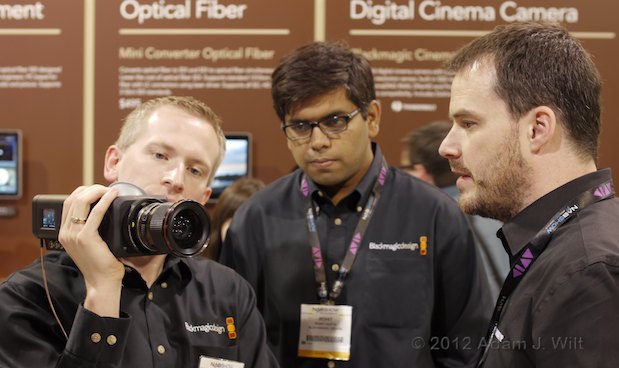
Ikonoskop’s Lukas Eisenhauer (on right) shows off the A-Cam dII to BMD folks.
May a thousand flowers bloom!
Pros
• 2.4K for a $3K, raw-capable camera with a sensor size midway between four thirds and Super16mm. ‘Nuff said.
• Records 2.4K raw or realtime-ready ProRes or DNxHD 1080p. This is huge. Raw is versatile, raw is powerful, but raw is a royal pain in the posterior when time and storage space are tight and the client wants to walk away with viewable media. The Arri Alexa is another raw-capable camera with HD ProRes recording on board; in our market (greater San Francisco area) the available Alexas are working night and day recording ProRes for immediate use. They almost never go out the door configured to record raw: the practical advantages of ProRes outweigh the theoretical advantages of raw almost every time (it doesn’t hurt that the Alexa allows you to record log gamma to ProRes as well as to raw files, just as the BMDCC appears able to).
• EF mount allows use of widely-available Canon EF, Zeiss ZE, and other 3rd-party lenses.
• Elegant, minimalist design with a responsive touchscreen and sure-touch raised membrane buttons for transport control, iris, and focus assist.
Cons
• The camera’s form factor, while well-suited to tripod work, is not ideal for handheld usage. The usual rods-and-cages suspects will surely have build-up kits for the BMDCC, but these will add to the cost of the off-tripod package.
• The EF mount limits the number of truly wide-angle lenses for the sub-four-thirds sensor, and most EOS (electronically-controlled aperture) lenses do not allow smooth iris changes while shooting.
• The 5″ touchscreen is only 800×480, which may prove to be frustrating for fine focus-finding.
Cautions
• No internal NDs (it’s funny how folks gave Sony endless grief about the lack of NDs in the large-sensor NEX-FS100, but I haven’t heard any complaints about the similar omission on the BMDCC). Plan on buying a nice variable ND for your largest lens, and step-up rings to put it on smaller ones.
• BMD has a history of soldering I/O connectors directly to circuit boards, instead of hard-mounting them to the equipment’s case and cabling them to the boards to prevent mechanical shock transmission and the resulting stress-induced failures. While this is common practice in consumer electronics, PCs, and the like, it’s frowned upon in the rough-and-tumble world of broadcasting and cinema cameras. If this construction is used in the BMDCC, you’ll want to treat your cable connections to the camera a bit more gently than normal, lest your casual treatment of the HD-SDI output or audio inputs lead to intermittent or complete failures of these important connectors.
• All of this is complete speculation until the danged camera ships! When it does, I’ll get one in for review. Stay tuned…
More Info
The emailed Press Release that stunned NAB on Monday morning.
Blackmagic’s Cinema Camera page.
Part 1 of my BMDCC NAB coverage.
Yes, of course there’s an enthusiast forum site already: BMCuser.com, for the BlackMagic Camera users among us… before, erm, the camera even exists to be used!
A mostly-accurate comparison of the Digital Bolex and the BMDCC.
Disclosures: I attended NAB on my own dime, with a press pass to save the cost of admission.
Blackmagic Design did not offer me any material consideration for a positive writeup, and there is no material connection between me and Blackmagic Design.
No material connection exists between myself and the National Association of Broadcasters; aside from the press pass, NAB has not influenced me with any compensation to encourage favorable coverage.

Filmtools
Filmmakers go-to destination for pre-production, production & post production equipment!
Shop Now